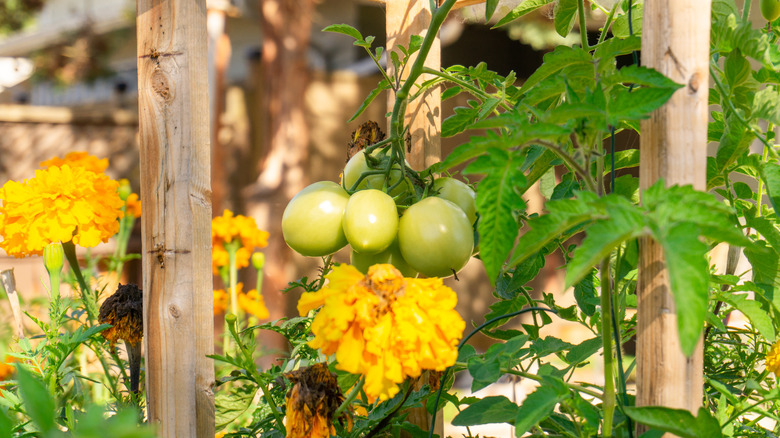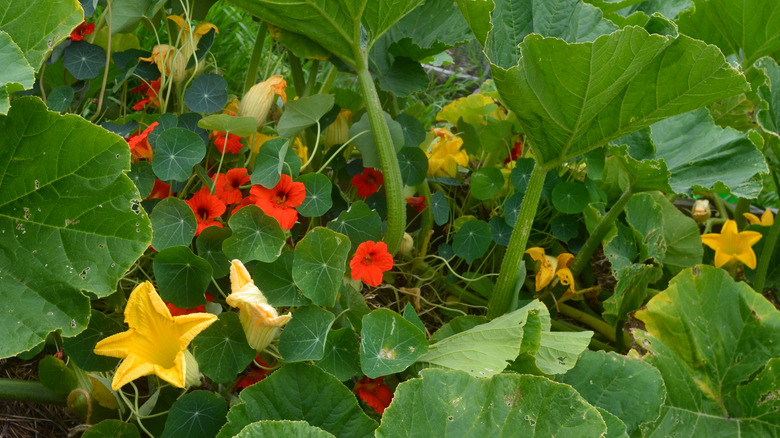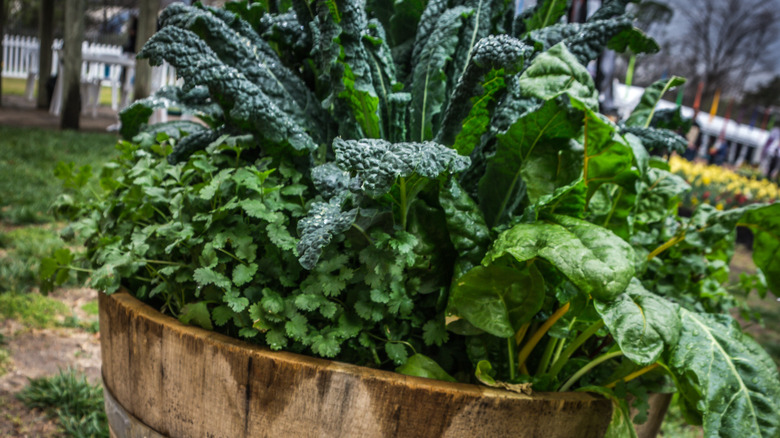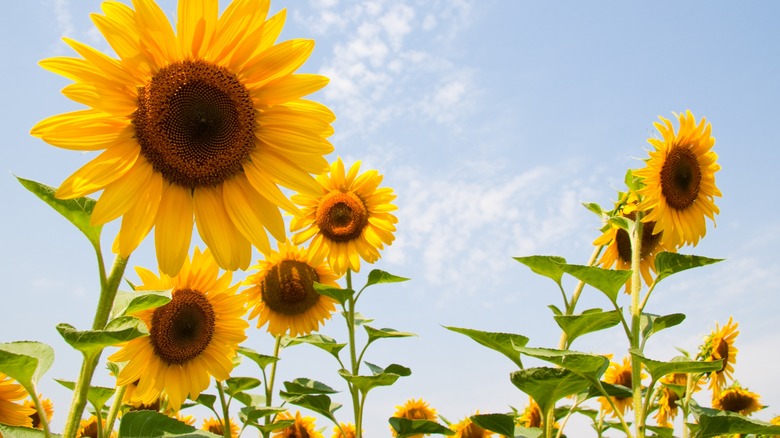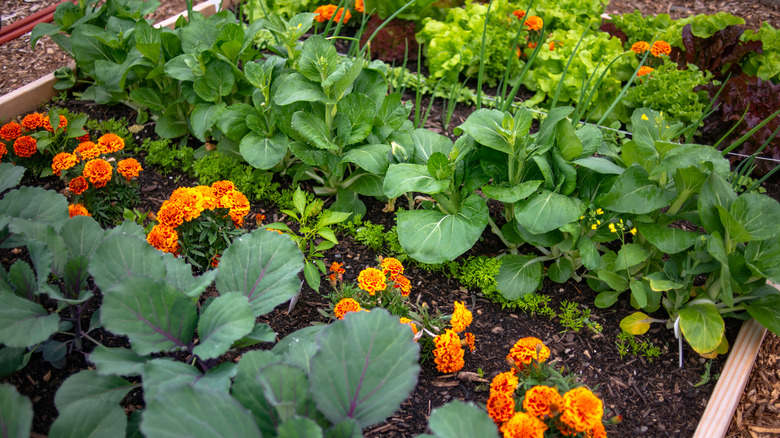What Is Companion Planting And How Does It Benefit Your Garden?
The more time one spends in the garden, the more one feels connected to the plants. We gardeners at House Digest can't be alone in this feeling. We're almost every day tending to our flowers and vegetables or shaping our landscaped shrubs and fruit trees; before we know it, it's as if we can anticipate each plant's needs and know just what to do to keep them thriving. The art of companion planting falls right in line with this desire to stay attuned to nature to grow a healthy garden.
The basic gist of companion planting is to plan the layout of your garden so that plants that benefit each other are grown in close proximity and those that require or create differing conditions are separated in other areas. Swansons Nursery adds that the method stems primarily from folk knowledge and anecdotal evidence compiled over generations of paying close attention to what works and what doesn't. This is evident in the centuries-old Native American practice of growing the Three Sisters, described by Native Seeds Search as combining the bean, corn, and squash crops to the mutual benefit of all three. We'll get into detail about those benefits and much more below.
Pest prevention
You may have read that marigolds are the ultimate flower to add to your garden if you want to repel bugs naturally. In reality, this is only partly true. Piedmont Master Gardeners point to a lack of comprehensive research on the subject, and you may have less-than-stellar experiences to draw upon. Furthermore, what about the 15 insects that the USDA says feed on those marigolds? Companion planting takes everything to the next level because it's not about searching for a blanket cure; instead, it looks at each plant and insect individually.
Here's an example: From the University of Minnesota Extension, we learn that while diamondback moths are an issue for brussels sprout crops, it's the squash bugs you have to worry about with your pumpkins. Each of these insects has its reaction to different companion crops. Diamondback moths don't like sage or thyme, and squash bugs prefer to steer clear of nasturtiums. With this information, you can conclude that your brussels sprouts will do well next to your sage, and your pumpkins will benefit from growing next to a patch of nasturtiums. As you start, companion planting in your garden can be as simple as growing one specific flower next to one vegetable to help ward off insects. Yet, it can become as detailed as incorporating a comprehensive plan considering deer, rabbits, plant-specific bugs, and more.
Soil health
Because it's the primary source of nutrition for in-ground or raised bed gardens, the state of your soil is one of the most important factors regarding each plant's overall health and growth rate. Soil pH, water retention, and the ratio of clay to sand to loam are just some aspects that affect a plant's ability to grow and produce fruit. The right balance can be difficult to strike in a standard nutrient-deficient suburban backyard, and oftentimes, the first suggestion you'll get is to amend your yard with soil conditioners. Mixing compost, pine bark, and other organic materials into the soil is not a bad idea, especially when setting up your garden.
Once again, companion planting will bump up your success a notch or two, this time because different crops alter the chemical composition of the soil in differing ways, and varying root systems can reduce compaction or reach nutrients and water sources that lay far below the surface, notes West Virginia University Extension. Back to the Three Sisters, Midwest Gardening demonstrates the beneficial relationship between beans and corn, stating that legumes transfer nitrogen from the air into the soil, feeding the nitrogen-hungry corn. As with pests, different plants will accomplish and benefit from different types of assistance.
Weed control
To receive the maximum benefits, companion plants are generally grown very close to each other, making it harder for weeds to pop up between them. Mother Earth News suggests fast-growing ground-level vegetables such as lettuce, cilantro, and mustard to fill in the empty gaps between plants like cabbage that need more room to grow. Again, we can look to the Three Sisters, where we find vigorously spreading squash vines acting as weed suppressants to help out the beans and the corn. Potatoes make another solid choice for planting under plants that grow upright, per The Old Farmer's Almanac, and pumpkins will help your berry bushes in the same way. It gets fascinating when we start to see how two otherwise unrelated fruits and vegetables ripen in contrasting seasons and can benefit each other.
There's also the concept of allelopathy, which Merriam-Webster defines as "the suppression of growth of one plant species by another due to the release of toxic substances." In companion planting, this means that certain plants can inhibit weeds from developing without affecting the growth of the other plants around them. Permaculture Research Institute explains that allelopathy can also force germination in parasitic weed seeds in areas with no viable host, eliminating their survival ability.
Shade and sun exposure regulation
We've been told a million times that all plants need water and sunlight to grow, but some prefer a less-is-more approach when it comes to light. Ground cover plants tend to love the shade, and plenty of beautiful flowers grow perfectly in the shade as well. You can certainly create shade by installing a structure like a pergola or an archway. Still, you can also do it in a completely natural way with companion planting, suggests the University of Minnesota Extension. In this way, tall companion plants act as barriers between low-growing, sun-averse plants and the harsh bright light of day. This encourages them to thrive in the environmental conditions best suited to them.
Mighty sunflowers, for example, stretch high into the sky to gobble up as many direct rays as possible. In doing so, notes Blooming Backyard, they create pockets of shadows beneath them that make the blazing heat bearable for shade-appreciative lettuces and summer squashes. Clemson Cooperative Extension Home & Garden Information Center says shading the soil also aids weed suppression by significantly restricting sun exposure.
Space economy
Yet another way the practice of companion planting is beneficial to your garden regards space efficiency. When you consider the factors we've discussed so far — filling empty gaps with ground covers, tucking low-growing shade-lovers under tall-growing sun-lovers, and planting crops with shallow root systems alongside those with deep roots — it's incredible just how many different plants you can fit into a relatively compact area. This is particularly helpful if all you have are some containers on a stoop, but it's also great for anyone with a standard issue in-ground garden who may also want room for a pool and a deck in their backyard.
Mother Earth Gardener mentions that you can plant various vegetables from the same family close together. Cruciferous brassicas (broccoli, Brussels sprouts, cabbage, cauliflower, etc.) will thrive when staggered, meaning you don't have to space them out in meticulous rows that waste space. The same goes for root vegetables (carrots, beets, radishes, etc.) which will be pretty happy alongside a surface grower like cabbage. Finally, add flowering herbs wherever they fit to entice the pollinators to your yard.
